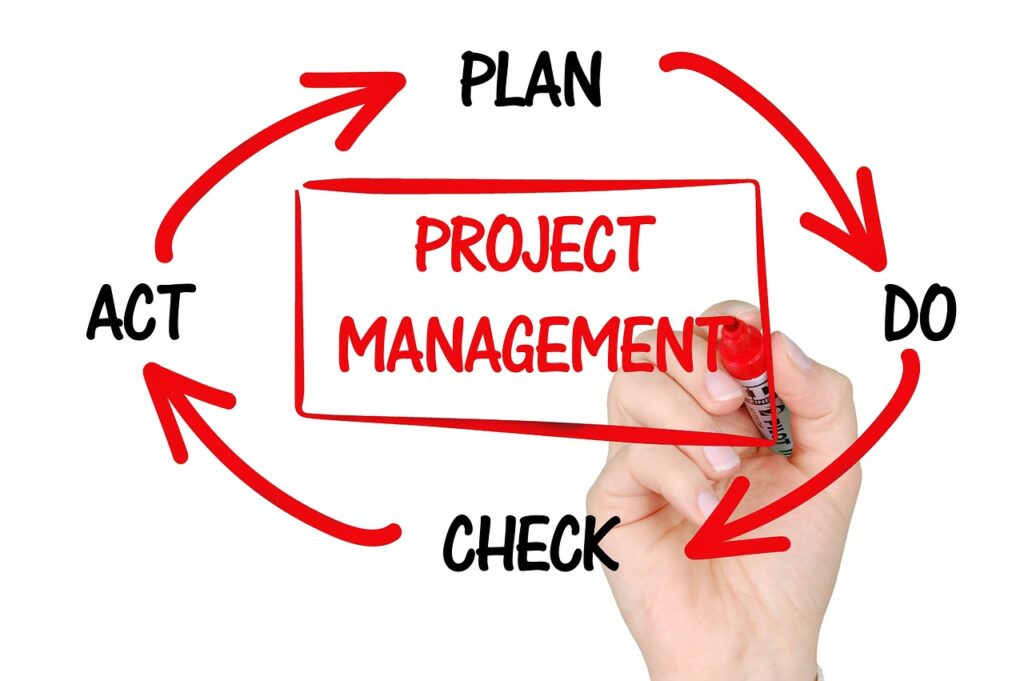The RACI matrix is the project management tool that eliminates the “who does what” at every meeting. It makes role assignment as clear as task execution. The result: a clear, structured and perfectly fluid flow of communication between stakeholders.
RACI: definition and importance of this matrix
The RACI matrix is a project management tool that assigns clear roles to each team member. The acronym RACI is defined as follows: Responsible (the person who carries out the task), Approver (the person who validates), Consulted (the experts who are consulted for advice) and Informed (those who are kept informed, but do not have to intervene). In short, everyone knows what to do and what not to do.

Using the RACI matrixYou use a project management tool to avoid confusion. It clarifies responsibilities and strengthens communication between team members. Thanks to the RACI matrix, everything is clearly defined, and everyone knows exactly what they have to do.
With this software, you can optimize project efficiency by eliminating duplication and misunderstandings. By assigning specific roles, this project management tool facilitates smooth task execution and seamless follow-up. Ultimately, this keeps the project on track, without anyone getting lost in the crowd of responsibilities.

RACI roles: understanding them and defining them clearly
The RACI matrix is a management tool which clarifies responsibilities, organizes roles within a team and provides a clear vision of tasks and their distribution. Here’s a detailed description of each role:
- Responsible (R): This is the person who carries out the task. He or she is in charge of the actual execution of the activity, and must ensure that it is carried out properly, on time and with the expected quality.
- Approver (A): the role of the Approver is essential, as he or she holds final authority and responsibility for the task. He is the one who validates the work carried out before it is considered finished or ready to move on to the next stage.
- Consulted (C): these are the people whose expertise is called upon during the execution of the task. Their role is to provide advice, information or feedback to help the job run smoothly.
- Informed (I): Informed people are kept up to date on the progress of the task or project, but have no direct involvement in its execution. They are regularly updated, but their role is passive in terms of decision-making.
- RASCI: today, the Support role is increasingly integrated into the RACI matrix. This role designates the people or groups capable of providing the resources required by Managers, whether in terms of personnel, materials or information.
Clear, precise roles to avoid confusion
It’s essential to differentiate between these roles to avoid confusion. For example, you mustn’t confuse Manager and Approver. The Manager executes the tasks, while the Approver validates the actions carried out. This distinction is crucial to the clear and efficient management of task lists, and helps to clarify each person’s responsibilities. A clear division of responsibilities helps to avoid work overload and guarantees better organization within the team.
Assigning roles: tips for getting the job done
To assign RACI roles effectively, it is essential to know the skills, authority and responsibilities of each team member. Roles must be assigned according to the tasks to be accomplished and the level of involvement required. L’ task execution must be aligned with these roles, ensuring that each member assumes his or her responsibilities in line with expectations. Involving the right people at the right time is key to ensuring that the project runs smoothly. A clear, structured communication flow and a clear understanding of the expectations of each role are essential to avoid ambiguity and ensure project success.
RACI matrix: how to implement this tool properly?
The RACI matrix (or its RASCI variant) is an invaluable tool for avoiding misunderstandings and clearly allocating responsibilities within a project. Here’s how to build it step by step, without getting bogged down in unnecessary jargon.
1. List all project tasks
First and foremost, you need to map out the project: what are the key stages, the deliverables, the actions to be taken? For example, for a product launch, this might include design, testing, communication, etc. The idea is to have a global vision of who will be involved where. The idea is to have a global vision so you know who will be involved where.
2. Identify all the players involved
Who’s involved? Suppliers, customers, management… and, of course, the teams whose involvement is necessary, even indirectly, to guarantee the company’s success staff satisfaction. An oversight here could lead to confusion later.
3. Assign roles (R, A, C, I... or S)
This is the heart of the job: for each task, we define who does what using the letters in the matrix:
R (Responsible): Carries the task at arm’s length.
A (Approver): Gives the final green light.
C (Consulted): To be solicited before deciding.
I (Informed): Put in the loop, no action required.
(S (Support) Spot reinforcements, if needed).
Example: To organize a meeting, the R could be the project assistant, the A the project manager, the C a business expert, and the I the management.
4. Review and adjust as a team
A first version is not enough! Present the matrix to the team to :
- Check that there are no duplicates (too many R’s on the same task) or gaps (a task without any R’s).
- Make sure everyone agrees with your missions.
- Correct ambiguities (“I thought you were in charge of that!”)
- Why is this good practice?
- Because it’s visual and shared. Everyone knows what’s expected of them, and who to contact if they get stuck. But don’t forget: the matrix must be kept alive! If the project evolves, revise it so that it remains useful.
Tip: Use a simple spreadsheet or even a flipchart to make it accessible to everyone.
Practical tips for successful implementation
For the RACI matrix to really work, here’s what works:
1. Involve those concerned from the outset
Present it in a meeting, not by e-mail. Ask their opinion: “Does it seem clear to you? Who needs to be added?” A good test: if someone says “I didn’t know it was me”, that means adjustments need to be made.
2. Use a simple, visible tool
A shared table (spreadsheet, Google Sheets) is all you need. Avoid complex software if the team isn’t comfortable with the “tech” side of things. Display it in the project space (physical or Slack/Teams).
3. Revisit it at key milestones
After each milestone, check :
- Aren’t the R’s overloaded?
- Aren’t the A’s blocking unnecessarily?
- Why does it matter?
- Avoid last-minute “It’s not me!
- Makes decisions more fluid (everyone knows who validates what).
Tip: If your project is going to last a long time, schedule a monthly reminder to review it. It doesn’t have to be a rigid document – the important thing is to keep it useful.
Furious, the ERP that brings order to your RACI matrix
When managing a project and setting up a RACI matrix, it’s essential to assign roles and responsibilities correctly. Furious offers you an ERP that acts as your organization’s superhero. With its intuitive interface and comprehensive functionality, this management software lets you centralize all the data you need to assign roles: who’s in charge, who’s an approver, and so on.
No more misunderstandings or duplicate tasks! With Furious, you can finally see at a glance where each task stands, assign clear roles to each person and avoid any confusion about who should do what. You’ll no longer have to search high and low to find out where a project is or who needs to be informed, because Furious takes care of everything for you. In short, it’s there to help you apply the RACI matrix and make your project management much simpler and smoother.
Boost your project management with Furious
Combine the RACI matrix with Furious, and you get the management software for smooth, surprise-free project tracking. The RACI matrix eliminates grey areas on roles and responsibilities, while Furious centralizes everything for real-time tracking, without having to juggle a thousand tools. The result: a more efficient team, better executed tasks, and projects that run smoothly.
And with Furious, you don’t have to chase after information – it’s all at your fingertips. Ready to transform your project management? With Furious, your goals are just a click away! Book your free demo today.
